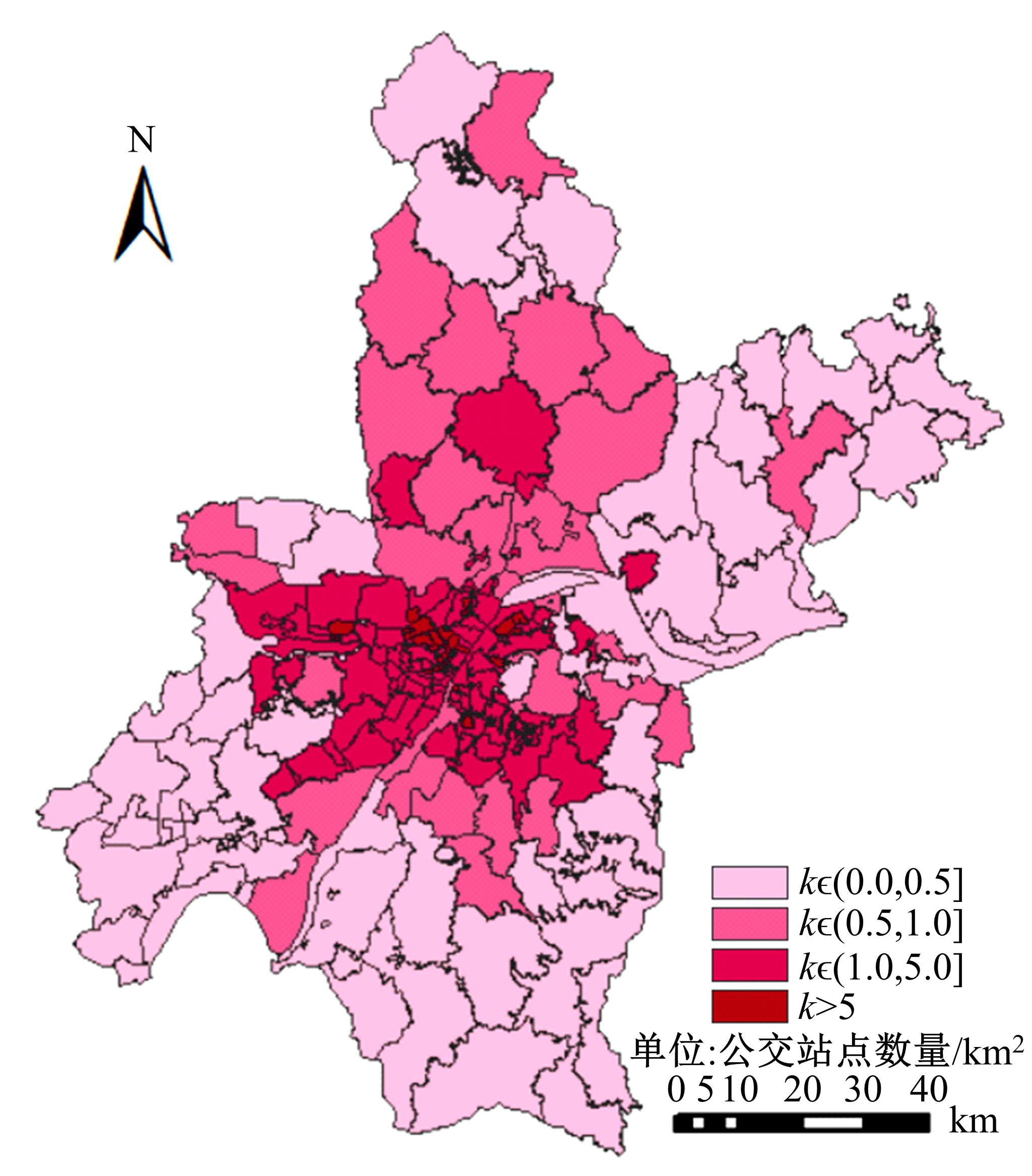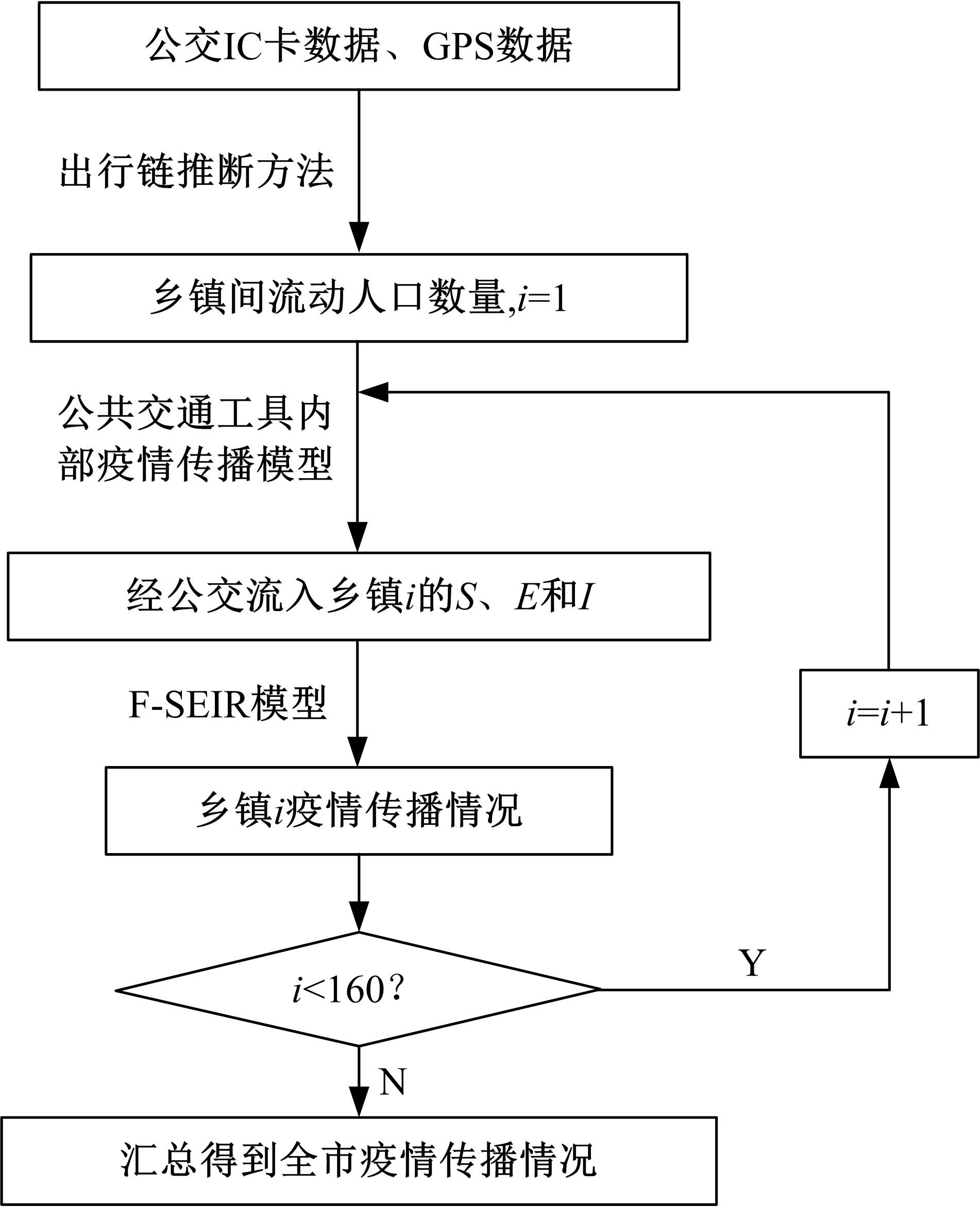吉林大学学报(工学版) ›› 2023, Vol. 53 ›› Issue (1): 141-149.doi: 10.13229/j.cnki.jdxbgxb20210587
• 交通运输工程·土木工程 • 上一篇
突发公共卫生事件下城市公交传播疫情模型
- 1.长安大学 运输工程学院,西安 710021
2.长安大学 未来交通学院,西安 710021
3.长安大学 智慧城市智能交通跨学科中心,西安 710021
Modeling urban bus transit spreading the epidemic under public health emergencies
Shao-jie WU1,2,3( ),Jian SUN1,2,3(
),Jian SUN1,2,3( )
)
- 1.College of Transportation Engineering,Chang'an University,Xi'an 710021,China
2.College of Future Transportation,Chang'an University,Xi'an 710021,China
3.Smart City and Intelligent Transportation Interdisciplinary Center,Chang'an University,Xi'an 710021,China
摘要:
为了揭示城市公交运行对城市内新型冠状病毒肺炎(COVID?19)传播的影响,通过建立考虑迁入者的F-SEIR模型,针对区域人口流动对疫情传播的影响进行分析。在考虑密闭公共交通工具内部疫情传播特性的基础上,建立了城市公交传播COVID?19模型。利用武汉市公交IC卡数据和公交车辆GPS数据,以武汉市160个街镇作为分析单元进行案例实证。结果表明:在公交影响下,城市疫情传播加速,多处出现“飞点传播”现象,整个城市感染者数量达70 446人。及时采取公交停运举措可使感染者数量降低18.64%~28.34%,实施越早,感染者数量减少越多。模拟COVID?19疫情中官方于2020年1月23日采取公交停运措施,其预测结果与官方公布疫情数据拟合优度达0.9675。相关研究成果和发现有助于揭示公共交通对城市内部疫情传播的影响,为复工复产后以及其他重大公共卫生事件发生时的风险判断及政策制定提供理论及决策依据。
中图分类号:
- U121
| 1 | 中国疾病预防控制中心新型冠状病毒肺炎应急响应机制流行病学组. 新型冠状病毒肺炎流行病学特征分析[J]. 中华流行病学杂志, 2020, 41(2): 145-151. |
| Epidemiology Working Group for NCIP Epidemic Response, Chinese Center for Disease Control and Prevention. The epidemiological characteristics of an outbreak of 2019 novel coronavirus diseases (COVID-19) in China[J]. Chinese Journal of Epidemiology, 2020,41(2): 145-151. | |
| 2 | Huang C, Wang Y, Li X, et al. Clinical features of patients infected with 2019 novel coronavirus in Wuhan, China[J]. The Lancet, 2020, 395(10223): 497-506. |
| 3 | Nian G Y, Peng B Z, Sun D J, et al. Impact of COVID-19 on urban mobility during post-epidemic period in megacities: from the perspectives of taxi travel and social vitality[J]. Sustainability, 2020, 12(19):No.12197954. |
| 4 | 张殿业, 郭寒英. 交通运输通道防控非典型肺炎(SARS)疫情的作用研究[J]. 交通运输工程与信息学报, 2003, 1(1): 31-36. |
| Zhang Dian-ye, Guo Han-ying. Effect of traffic and transportation prevention and controlling sever acute respiratory syndrome epidemic situation[J]. Journal of Transportation Engineering and Information, 2003, 1(1): 31-36. | |
| 5 | 郭寒英, 张殿业, 石红国. 交通运输突发疫情扩散理论与模型研究[J]. 铁道运输与经济, 2004, 26(2):65-67. |
| Guo Han-ying, Zhang Dian-ye, Shi Hong-guo. Spreading theory and model study of broke-out diseases in traffic and transportation[J]. Railway Transport and Economy, 2004, 26(2): 65-67. | |
| 6 | 杨华, 李小文, 施宏,等. SARS沿交通线的"飞点"传播模型[J]. 遥感学报, 2003, 7(4): 251-255. |
| Yang Hua, Li Xiao-wen, Shi Hong, et al. "Fly dots" spreading model of SARS along transportation[J]. Journal of Remote Sensing, 2003, 7(4): 251-255. | |
| 7 | 刘亚岚, 阎守邕, 李小文,等. 中国内地人口流动空间规律研究及其在SARS控制宏观决策中的应用[J]. 遥感学报, 2003, 7(4): 273-276. |
| Liu Yan-lan, Yan Shou-yong, Li Xiao-wen, et al. Study on population migration characteristics in mainland China and its applications to decision-making for SARS control[J]. Journal of Remote Sensing, 2003, 7(4): 273-276. | |
| 8 | 张云. 中国大陆地区甲型H1N1流感疫情传播的建模与分析[D]. 北京:北京师范大学地理科学学部, 2011. |
| Zhang Yun. Modeling and analysis of influenza a (H1N1) epidemiology in mainland of China[D]. Beijing: Beijing Normal University, Faculty of Geographical Science, 2011. | |
| 9 | Fang L Q, Vlas S J D, Feng D, et al. Geographical spread of SARS in mainland China[J]. Tropical Medicine & International Health, 2009, 14(Sup.1): 14⁃20. |
| 10 | Khan K, Arino J, Hu W, et al. Spread of a novel influenza A (H1N1) virus via global airline transportation[J]. N Engl J Med, 2009, 361(2): 212-214. |
| 11 | Anderson R M, Heesterbeek H, Klinkenberg D D, et al. How will country-based mitigation measures influence the course of the COVID-19 epidemic[J]. The Lancet, 2020, 395(10228): 931-934. |
| 12 | Roosa K, Lee Y, Luo R, et al. Real-time forecasts of the 2019-nCoV epidemic in China from February 5th to February 24th, 2020[J]. Infectious Disease Modelling, 2020, 5:256-263. |
| 13 | Tang B, Wang X, Li Q, et al. Estimation of the transmission risk of the 2019-nCoV and its implication for public health interventions[J]. Journal of Clinical Medicine,2020,9(2): No.9020462. |
| 14 | 程晓敏, 李芊璘, 陆家海. 从2019新型冠状病毒病疫情谈新发传染病防控策略[J]. 传染病信息, 2020, 33(1): 22-26. |
| Cheng Xiao-min, Li Qian-lin, Lu Jia-hai. Prevention and control strategies for emerging infectious diseases based on the outbreak of coronavirus disease 2019[J]. Infectious Disease Information, 2020, 33(1): 22-26. | |
| 15 | Kucharski A J, Russell T W, Diamond C, et al. Early dynamics of transmission and control of COVID-19: a mathematical modelling study[J]. The Lancet Infectious Diseases, 2020, 20(5): 553-558. |
| 16 | You C, Deng Y H, Hu W J, et al. Estimation of the time-varying reproduction number of COVID-19 outbreak in China[J]. International Journal of Hygiene and Environmental Health, 2020, 228: No.113555. |
| 17 | Yang Z, Zeng Z, Wang K,et al. Modified SEIR and AI prediction of the epidemics trend of COVID-19 in China under public health interventions[J]. Journal of Thoracic Disease,2020,12(3): 165-174. |
| 18 | 中华人民共和国国家卫生健康委员会. 新型冠状病毒肺炎诊疗方案(试行第六版)[J]. 中国感染控制杂志, 2020, 19(2): 192-195. |
| National Health Commission of the People's Republic of China.Diagnosis and treatment plan for novel coronavirus pneumonia(trial version 6)[J]. Chinese Journal of Infection Control, 2020, 19(2): 192-195. | |
| 19 | 靳英辉,蔡林,程真顺,等.新型冠状病毒(2019-nCoV)感染的肺炎诊疗快速建议指南(标准版)[J]. 解放军医学杂志, 2020, 45(1): 1-20. |
| Jin Ying-hui, Cai Lin, Cheng Zhen-shun, et al. A rapid advice guideline for the diagnosis and treatment of 2019 novel coronavirus (2019-nCoV) infected pneumonia (standard version)[J]. Medical Journal of Chinese People's Liberation Army, 2020, 45(1): 1-20. | |
| 20 | Li Q, Guan X, Wu P, et al. Early transmission dynamics in Wuhan, China, of novel coronavirus-infected pneumonia[J]. The New England Journal of Medicine, 2020, 382(13): 1199-1207. |
| 21 | Zhang J, Lou J, Ma Z, et al. A compartmental model for the analysis of SARS transmission patterns and outbreak control measures in China[J]. Applied Mathematics & Computation, 2005, 162(2): 909-924. |
| 22 | Lin K, Fong D, Zhu B, et al. Environmental factors on the SARS epidemic: air temperature, passage of time and multiplicative effect of hospital infection [J]. Epidemiology and Infection, 2006, 134(2): 223-230. |
| 23 | 陈文江,吴开琛,吴开录,等.运用数学模型探讨SARS聚集性传播的机制[J].中国热带医学, 2004, 4(1): 20-23. |
| Chen Wen-jiang, Wu Kai-chen, Wu Kai-lu, et al. Approach to the mechanism of cluster transmission of SARS by mathematical model [J]. China Tropical Medicine, 2004, 4(1): 20-23. | |
| 24 | 张宇, 田万利, 吴忠广,等. 基于改进SEIR模型的新冠肺炎疫情沿交通线路传播机制[J]. 交通运输工程学报, 2020, 20(3): 150-158. |
| Zhang Yu, Tian Wan-li, Wu Zhong-guang, et al. Study on transmission mechanism of COVID-19 epidemic along traffic lines based on improved SEIR model[J]. Journal of Traffic and Transportation Engineering, 2020, 20(3): 150-158. | |
| 25 | 国家统计局. 第六次全国普查汇总数据[R]. 北京:中国统计出版社,2010. |
| 26 | 李佳怡, 张锦, 张静文,等. 城市公交乘客下车站点推算方法和有效性评价[J]. 武汉大学学报:信息科学版, 2018, 43(8): 1172-1177. |
| Li Jia-yi, Zhang Jin, Zhang Jing-wen, et al. An algorithm to identify passengers' alighting stations and the effectiveness evaluation[J]. Geomatics and Information Science of Wuhan University, 2018, 43(8): 1172-1177. |
| [1] | 张雅丽,付锐,袁伟,郭应时. 考虑能耗的进出站驾驶风格分类及识别模型[J]. 吉林大学学报(工学版), 2023, 53(7): 2029-2042. |
| [2] | 张惠臻,高正凯,李建强,王晨曦,潘玉彪,王成,王靖. 基于循环神经网络的城市轨道交通短时客流预测[J]. 吉林大学学报(工学版), 2023, 53(2): 430-438. |
| [3] | 李兴华,冯飞宇,成诚,王洧,唐鹏程. 网约拼车服务选择偏好分析及建模[J]. 吉林大学学报(工学版), 2022, 52(3): 578-584. |
| [4] | 刘志伟,刘建荣,邓卫. 基于潜在类别的无人驾驶汽车选择行为[J]. 吉林大学学报(工学版), 2021, 51(4): 1261-1268. |
| [5] | 江亮,贺宜. 电动两轮车风险驾驶行为及事故影响因素分析[J]. 吉林大学学报(工学版), 2019, 49(4): 1107-1113. |
| [6] | 房瑞伟, 张谢东, 姜攀. 基于SWOT-AHP的城市快速交通规划[J]. 吉林大学学报(工学版), 2017, 47(4): 1055-1060. |
| [7] | 赵学彧, 杨家其, 彭亚美. 城市轨道交通与地面公交竞合关系演化机制[J]. 吉林大学学报(工学版), 2017, 47(3): 756-764. |
| [8] | 胡宏宇,李志慧,魏巍,曲昭伟,陈正全. 基于模糊逻辑的信号交叉口人车冲突判别方法[J]. 吉林大学学报(工学版), 2014, 44(3): 637-641. |
| [9] | 邵敏华, 孙立军, 邵显智. 基于转弯比例的网络检测器布设模型及算法[J]. 吉林大学学报(工学版), 2013, 43(06): 1476-1481. |
| [10] | 曲昭伟, 魏福禄, 魏巍, 李志慧, 胡宏宇. 雷达与视觉信息融合的行人检测方法[J]. 吉林大学学报(工学版), 2013, 43(05): 1230-1234. |
| [11] | 魏巍, 李志慧, 赵永华, 曲昭伟, 江晟, 柴婷婷. 基于智能相机的混合交通流检测方法[J]. 吉林大学学报(工学版), 2013, 43(04): 866-870. |
| [12] | 赵莹莹, 曲昭伟, 江晟, 胡宏宇, 胡金辉. 基于视频的行人过街速度特性[J]. 吉林大学学报(工学版), 2013, 43(02): 298-303. |
| [13] | 江晟, 王殿海, 赵莹莹, 胡宏宇. 混合交通特征表达及快速检测算法[J]. , 2012, (06): 1459-1464. |
| [14] | 金立生, 咸化彩, 祖力, 孙玉芹, 侯海晶, 牛清宁. 小区民用车辆车牌自动识别算法[J]. 吉林大学学报(工学版), 2012, 42(增刊1): 166-169. |
| [15] | 王霄维, 王殿海, 江晟, 金盛. 基于混合优化模型的平面交叉口控制方法[J]. 吉林大学学报(工学版), 2012, 42(增刊1): 170-174. |
|
||

















